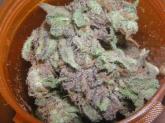Conference Coverage


AT AES 2014
SEATTLE – Cannabinoid therapy holds promise for the treatment of pediatric epilepsy, but more research is needed to rigorously assess its safety and efficacy, according to experts in the field.
Cannabis contains numerous cannabinoids, including the nonpsychoactive cannabidiol (CBD) and the psychoactive tetrahydrocannabinol (THC).
Two CBD products – an oil-based extract (Epidiolex) and an oral solution (Insys Therapeutics) – have been granted orphan drug status by the Food and Drug Administration for treatment of some forms of epilepsy. In addition, families can obtain artisanal preparations, which may contain a variety of cannabinoids as well as other chemical compounds.
However, use and study of cannabinoids in the United States has been complicated by the federal classification of marijuana as a schedule I controlled substance and the patchwork legal status of medical and recreational use across states.
Investigators reported findings of several clinical studies of cannabinoid therapy in pediatric epilepsy at the annual meeting of the American Epilepsy Society and discussed implications for clinical practice and future research, as well as legal and regulatory status of this therapy.
Benefit may be greatest in Dravet syndrome
Dr. Orrin Devinsky, director of the Comprehensive Epilepsy Center at the NYU Langone Medical Center, and his colleagues undertook a prospective, open-label, multicenter, observational study among pediatric patients with treatment-resistant epilepsy.
In the study, supported in part by GW Pharmaceuticals, 151 patients were treated with Epidiolex, added to their baseline regimen of up to three antiepileptic drugs (AEDs).
Main efficacy analyses based on the 58 patients treated for at least 3 months showed that the median reduction in seizure frequency was about 35% overall and 55% for patients with Dravet syndrome.
The 3-month rate of seizure freedom was 10% overall and 22% in the subset with Dravet syndrome. “These were much higher rates than we would expect, for example, from a placebo response alone,” Dr. Devinsky said in a press briefing.
Data from the 40 patients having longer follow-up, at least 16 weeks, showed that benefit was sustained, indicating that patients did not develop tolerance.
Safety results for all 151 patients showed the most common adverse events were somnolence, seen in 19% of patients, and fatigue, seen in 11%. A single serious adverse event, status epilepticus, was considered possibly related to the CBD. Laboratory measures did not show any noteworthy changes.
“Based on the experience at these five sites, in an open-label, nonrandomized controlled trial ... there is good evidence that the Epidiolex 98% product of CBD is an effective drug for many children with treatment-resistant epilepsy, that the patients with Dravet syndrome appear to be the most responsive ones (but again, this is a relatively small population right now), that the drug overall is quite well tolerated, and most of the side effects when they occur are relatively mild and oftentimes limited,” Dr. Devinsky said.
“The critical take-home message is that these are promising early results, but we need controlled trials to know how to move forward, he said, noting that randomized phase III trials are planned in both patients with Dravet syndrome and patients with Lennox-Gastaut syndrome.
Classifying CBD as schedule I – reserved for drugs having a high danger of abuse, lack of acceptable safety data, and no potential therapeutic benefit – presents hurdles for researchers and doesn’t make sense, according to Dr. Devinsky, who disclosed no relevant conflicts of interest.
“Cannabidiol is approved as part of Sativex, for example, in more than 25 European countries and Canada [for treatment of spasticity due to multiple sclerosis]. So we know it’s got benefit in double-blind studies, so that part ... is wrong. And cannabidiol has been tested extensively in humans. We have adult safety data; this drug’s been on the market,” he explained. So we know it’s wrong to schedule it as schedule I. And it’s not at all clear to many of us why the [Drug Enforcement Agency] is persisting in this scheduling classification.”
Impact on levels of AEDs is unpredictable
Investigators led by Dr. Daniel Friedman, director of both the ICU Epilepsy Monitoring Service and the Epilepsy Consult Service at NYU Langone Medical Center, assessed levels of coadministered AEDs in 57 patients from the above study. He noted that such research is important as preclinical data suggest that CBD inhibits enzymes that metabolize commonly used AEDs.
Results showed that over the first 2 months of CBD therapy, 33% of patients on valproate and 24% of patients on clobazam (Onfi) had their doses reduced because they experienced elevated drug levels or sedation attributed to the drugs, Dr. Friedman reported.


